
Oak apple or oak gall is the common name for a large, round, vaguely apple-like gall commonly found on many species of oak. Oak apples range in size from 2 to 4 centimetres in diameter and are caused by chemicals injected by the larva of certain kinds of gall wasp in the family Cynipidae. The adult female wasp lays single eggs in developing leaf buds. The wasp larvae feed on the gall tissue resulting from their secretions, which modify the oak bud into the gall, a structure that protects the developing larvae until they undergo metamorphosis into adults.

Andricus kollari, also known as the marble gall wasp, is a parthenogenetic species of wasp which causes the formation of marble galls on oak trees. Synonyms for the species include Cynips kollari, Andricus quercusgemmae, A. minor, A. indigenus and A. circulans.

Cynipini is a tribe of gall wasps. These insects induce galls in plants of the beech and oak family, Fagaceae. They are known commonly as the oak gall wasps. It is the largest cynipid tribe, with about 936 to 1000 recognized species, most of which are associated with oaks. The tribe is mainly native to the Holarctic. Cynipini wasps can act as ecosystem engineers. Their galls can become hosts of inquilines, and the wasps themselves are hosts to parasitoids.
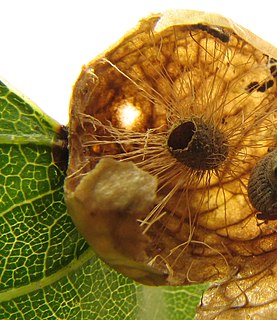
Amphibolips is an American genus of gall wasps in the family Cynipidae. There are about 57 described species in the genus Amphibolips with several others still undescribed.
Atrusca trimaculosa, also known as the woollybear gall wasp, is a species of gall wasp. This wasp is found on a variety of oak trees, including valley oak, blue oak, and Oregon oak. Its galls are 3-4 mm wide, round, and covered in stiff hairs. The galls are located on leaves, and often clustered together. Only females of this species are known.

Amphibolips quercusinanis, known generally as the larger empty oak apple wasp, is a species of gall wasp in the family Cynipidae.
Andricus mukaigawae is a species of gall wasp native to southeastern Asia. It creates galls on the buds and leaves of oak trees. The galls are sometimes used by other gall wasps unable to create galls of their own, with both species sharing the gall.

Disholcaspis quercusmamma, the oak rough bulletgall wasp, is a species of gall wasp in the family Cynipidae. The quercus in its name is the genus name for oak, while "mamma" is Latin for "breast", presumably a reference to the "nipple" on the gall.
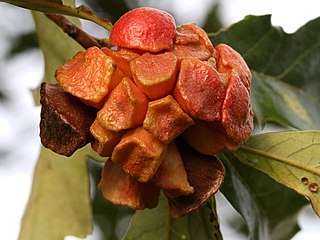
Andricus quercusstrobilanus, the lobed oak gall wasp, is a species of gall wasp in the family Cynipidae, found in North America. The quercus in its specific name is the genus name for oak, while "strobilus" is derived from the Greek strobilo which means "cone", a reference to the cone shape of the gall; thus the gall is sometimes called pine cone oak gall.
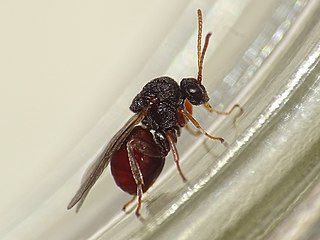
Amphibolips quercusostensackenii is a species of gall wasp in the family Cynipidae. It is found throughout eastern North America.

Phylloteras volutellae, the conical oak gall wasp, is a species of gall wasp , tribe Cynipini , found in North America.
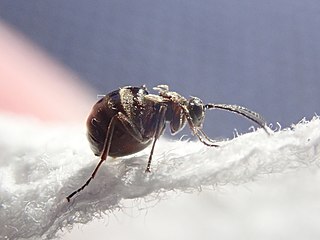
Acraspis quercushirta, the jewel oak gall wasp, is a species of gall wasp in the family Cynipidae, tribe Cynipini , found in North America.
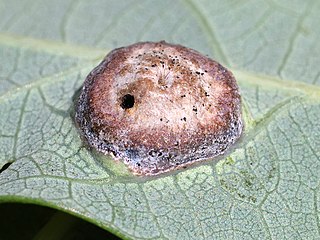
Callirhytis quercusfutilis, the oak wart gall wasp, is a species of gall wasp in the family Cynipidae.
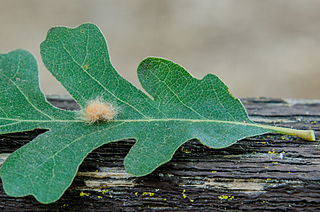
Druon fullawayi, also known as the yellow wig gall wasp, is a species of gall wasp in the family Cynipidae. It was previously placed in the genus Andricus. William Beutenmüller described the female adult wasps as 1.5-2.25 mm long, black with brown mouth parts and brown legs. The galls of D. fullawayi are tan or yellow, woolly, and measure 5-8 mm in diameter. Each gall holds a single chamber for larvae. They are found in California on oak trees, especially Quercus lobata.

Andricus crystallinus, also known as the crystalline gall wasp, is a species of gall-forming wasp in the genus Andricus. Its galls are pink and covered in hairs that are white, red, or brown. These galls are often massed together in clumps that can cover the underside of leaves. Individual galls are 12-14 mm high, 7 mm across, and have a single chamber for larvae. The unisexual female generation emerges in late winter, and the bisexual generation of males and females emerges in March. They are found in all species of oaks in California.
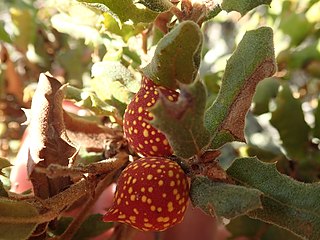
Burnettweldia is a genus of oak gall wasps in the Nearctic.

Andricus parmula, also known as the disc gall wasp, is a species of gall-forming wasp in the genus Andricus. It induces galls in a wide selection of oak species, including hybrids. The galls are disc-shaped, up to 3 mm in diameter, and pale with red streaking. Adult females emerge in April.

Andricus gigas, also known as the saucer gall wasp, is a species of gall-forming wasp in the genus Andricus. It induces galls on the leaves of scrub oaks, blue oaks, and Engelmann oaks. The galls produced by its all-female generation, which emerges in winter, are 3-4 mm wide, circular with raised edges. They are red, pink, brown, or purple. The larval chamber exists as a raised bump in the gall's center. The bisexual generation produces galls that are brown and cone-shaped.
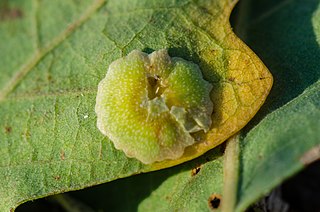
Andricus pattersonae, also known as the plate gall wasp, is a species of gall-forming wasp in the genus Andricus. Their hosts are among the white oaks grouping of oaks, with blue oak being common.
Druon quercuslanigerum is a species of gall wasp that forms galls on Quercus virginiana, Quercus geminata, Quercus fusiformis, and Quercus oleoides. There are both parthenogenic and sexual generations. The parthenogenic generation forms galls on the leaves whereas the sexual generation forms galls on the catkins. It can be found in the southern United States and Mexico. Predators of this species include the Green parakeet.
















